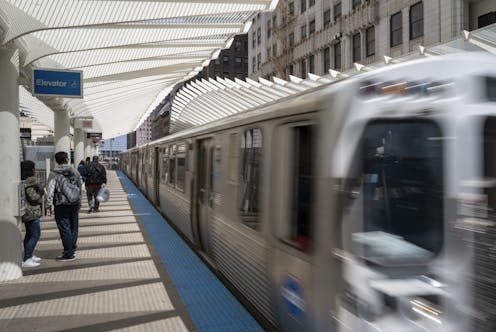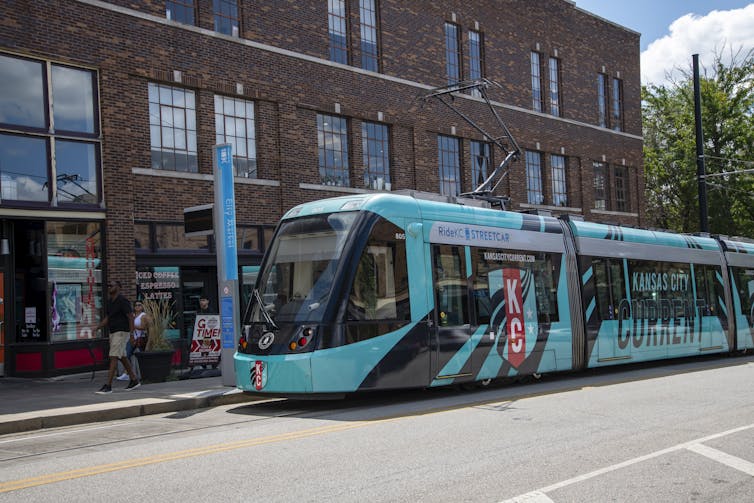Low-cost, high-quality public transportation will serve the public better than free rides
Everyone likes getting something for nothing, but history shows why the math behind free public transit doesn’t add up.

Public transit systems face daunting challenges across the U.S., from pandemic ridership losses to traffic congestion, fare evasion and pressure to keep rides affordable. In some cities, including Boston, Kansas City and Washington, many elected officials and advocates see fare-free public transit as the solution.
Federal COVID-19 relief funds, which have subsidized transit operations across the nation at an unprecedented level since 2020, offered a natural experiment in free-fare transit. Advocates applauded these changes and are now pushing to make fare-free bus lines permanent.
But although these experiments aided low-income families and modestly boosted ridership, they also created new political and economic challenges for beleaguered transit agencies. With ridership still dramatically below pre-pandemic levels and temporary federal support expiring, transportation agencies face an economic and managerial “doom spiral.”
Free public transit that doesn’t bankrupt agencies would require a revolution in transit funding. In most regions, U.S. voters – 85% of whom commute by automobile – have resisted deep subsidies and expect fare collection to cover a portion of operating budgets. Studies also show that transit riders are likely to prefer better, low-cost service to free rides on the substandard options that exist in much of the U.S.

Why isn’t transit free?
As I recount in my new book, “The Great American Transit Disaster,” mass transit in the U.S. was an unsubsidized, privately operated service for decades prior to the 1960s and 1970s. In the 19th and early 20th centuries, prosperous city dwellers used public transit to escape from overcrowded urban neighborhoods to more spacious “streetcar suburbs.” Commuting symbolized success for families with the income to pay the daily fare.
These systems were self-financing: Transit company investors made their money in suburban real estate when rail lines opened up. They charged low fares to entice riders looking to buy land and homes. The most famous example was the Pacific Electric “red car” transit system in Los Angeles that Henry Huntingdon built to transform his vast landholdings into profitable subdivisions.
However, once streetcar suburbs were built out, these companies had no further incentive to provide excellent transit. Unhappy voters felt suckered into crummy commutes. In response, city officials retaliated against the powerful transit interests by taxing them heavily and charging them for street repairs.
Meanwhile, the introduction of mass-produced personal cars created new competition for public transit. As autos gained popularity in the 1920s and 1930s, frustrated commuters swapped out riding for driving, and private transit companies like Pacific Electric began failing.
Grudging public takeovers
In most cities, politicians refused to prop up the often-hated private transit companies that now were begging for tax concessions, fare increases or public buyouts. In 1959, for instance, politicians still forced Baltimore’s fading private transit company, the BTC, to divert US$2.6 million in revenues annually to taxes. The companies retaliated by slashing maintenance, routes and service.
Local and state governments finally stepped in to save the ruins of the hardest-strapped companies in the 1960s and 1970s. Public buyouts took place only after decades of devastating losses, including most streetcar networks, in cities such as Baltimore (1970), Atlanta (1971) and Houston (1974).
These poorly subsidized public systems continued to lose riders. Transit’s share of daily commuters fell from 8.5% in 1970 to 4.9% in 2018. And while low-income people disprortionately ride transit, a 2008 study showed that roughly 80% of the working poor commuted by vehicle instead, despite the high cost of car ownership.
There were exceptions. Notably, San Francisco and Boston began subsidizing transit in 1904 and 1918, respectively, by sharing tax revenues with newly created public operators. Even in the face of significant ridership losses from 1945 to 1970, these cities’ transit systems kept fares low, maintained legacy rail and bus lines and modestly renovated their systems.
Converging pressures
Today, public transit is under enormous pressure nationwide. Inflation and driver shortages are driving up operating costs. Managers are spending more money on public safety in response to rising transit crime rates and unhoused people using buses and trains for shelter.
Many systems are also contending with decrepit infrastructure. The American Society of Civil Engineers gives U.S. public transit systems a grade of D-minus and estimates their national backlog of unmet capital needs at $176 billion. Deferred repairs and upgrades reduce service quality, leading to events like a 30-day emergency shutdown of an entire subway line in Boston in 2022.
Despite flashing warning signs, political support for public transit remains weak, especially among conservatives. So it’s not clear that relying on government to make up for free fares is sustainable or a priority.
For example, in Washington, conflict is brewing within the city government over how to fund a free bus initiative. Kansas City, the largest U.S. system to adopt fare-free transit, faces a new challenge: finding funding to expand its small network, which just 3% of its residents use
A better model
Other cities are using more targeted strategies to make public transit accessible to everyone. For example, “Fair fare” programs in San Francisco, New York and Boston offer discounts based on income, while still collecting full fares from those who can afford to pay. Income-based discounts like these reduce the political liability of giving free rides to everyone, including affluent transit users.
Some providers have initiated or are considering fare integration policies. In this approach, transfers between different types of transit and systems are free; riders pay one time. For example, in Chicago, rapid transit or bus riders can transfer at no charge to a suburban bus to finish their trips, and visa versa.
Fare integration is less costly than fare-free systems, and lower-income riders stand to benefit. Enabling riders to pay for all types of trips with a single smart card further streamlines their journeys.
As ridership grows under Fair Fares and fare integration, I expect that additional revenue will help build better service, attracting more riders. Increasing ridership while supporting agency budgets will help make the political case for deeper public investments in service and equipment. A virtuous circle could develop.
History shows what works best to rebuild public transit networks, and free transit isn’t high on the list. Cities like Boston, San Francisco and New York have more transit because voters and politicians have supplemented fare collection with a combination of property taxes, bridge tolls, sales taxes and more. Taking fares out of the formula spreads the red ink even faster.
Nicholas Dagen Bloom does not work for, consult, own shares in or receive funding from any company or organization that would benefit from this article, and has disclosed no relevant affiliations beyond their academic appointment.
Read These Next
RFK Jr. wants to scrutinize the vaccine schedule – but its safety record is already decades long
Federal officials are questioning the safety of the vaccine series children receive. Here’s the story…
Deception and lies from the White House to justify a war in Venezuela? We’ve seen this movie before
Two US wars based on lies, in which tens of thousands of American troops and millions of civilians died,…
Miami’s new mayor faces a housing affordability crisis, city charter reform and a shrinking budget
Eileen Higgins won a hard-fought election to become Miami’s new mayor. Now for the hard part – governing…






